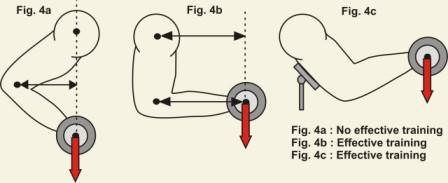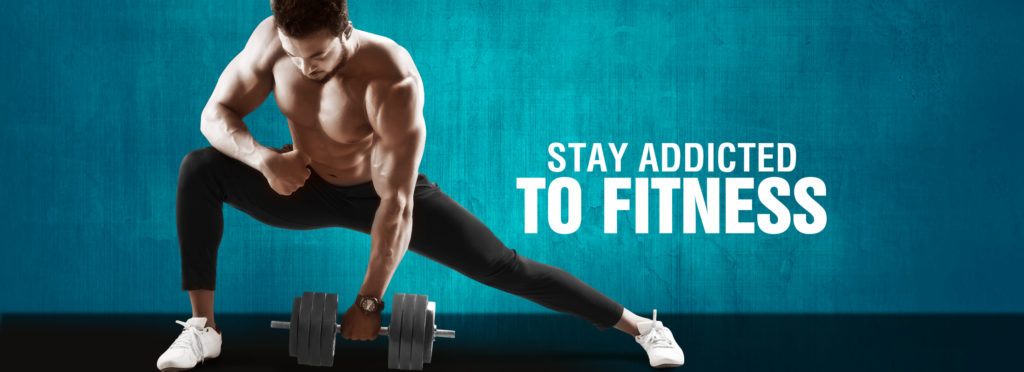
Every sporting movement involves numerous different forces, which are subject to certain laws. A rough grasp of, and taking due note of, these laws will ensure that not only your strength training is easy on your joints but your endurance training is energy saving. It will also help you to recognize to some extent unusual strains exerted on the passive motor system during certain lift techniques and thereby avoid incorrect movements.
The diagram below shows how expenditure of energy is determined by the proximity of the weight to be lifted from the initial position. The forces are shown as arrows, which also indicate the size and direction of the force. A weight of roughly 20 kgs. is thus subject to a gravity of about 100 newtons. The Newton unit is a measure of force, and when directed vertically downwards the force expressed in newtons is always ten times the relevant weight. If a force operates on a point from a given distance, torque is exercised on it. The torque is thus the product of the effective force and the length of the lift. If two forces from opposite directions operate on a point, they stand in balance if the product of the length of the lifting arm and the force is equal.
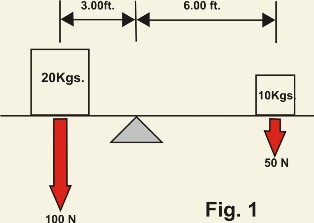
Fig. 1 : the balance of forces of two different loads. Being at different distances from the pivot point, they develop different torque. The product (force x distance from pivot) is equal, e.g. 100 newtons x 3 ft. = 50 newtons x 6 ft.
Fig. 2: the energy used by the back muscles for establishing balance at the center of gravity: if the center of gravity of the upper body as pivot is thrice as far from the vertebral bodies as the distance of the back muscles behind the pivotal point, the tractive power of the back muscles must be thrice as large as the weight of the upper body.
As the torque with an unchanged load and longer lift gets greater and greater, the load on the structure concerned also increases. The consequence for both strength and endurance training is that weights moved or parts of the body moved should be as close to the body as possible, partly in order not to overstrain the kinesthetic system and partly to save energy.
In an erect, immobile body there are a multiplicity of levers and forces which must ultimately be in balance so that the body does not move. In every immobile body there is a point where it can be hung up so that, however it is rotated from this point, it will always be in balance.
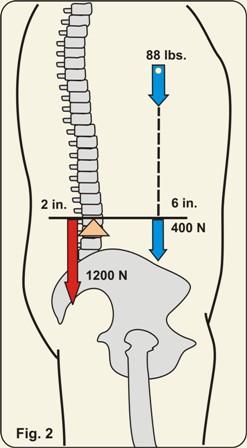
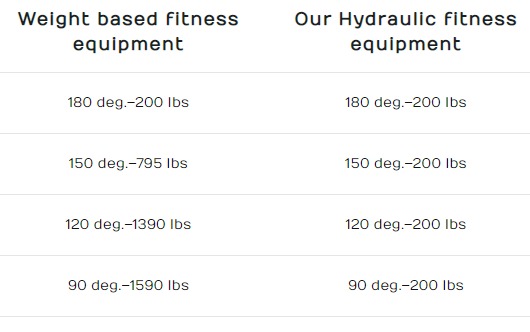
In case of the weight based equipment, the load of 110 lbs at 180 degree is equivalent to 200 lbs, at 150 degree is equivalent to 795 lbs, at 120 degree is equivalent to 1390 lbs and the same load is equivalent to 1590 lbs at 90 degree.
In case of our hydraulic fitness equipment, the load of 110 lbs at 180 degree is equivalent to 200 lbs and it is the same throughout the range of motion i.e. at each angle it is 200 lbs as these equipment adjust automatically and continuously to the strength, power, speed output and the need of the person using it or with the capacity of the user. The user can never apply more force than his capacity.
In case of our hydraulic fitness equipment, the load of 110 lbs at 180 degree is equivalent to 200 lbs and it is the same throughout the range of motion i.e. at each angle it is 200 lbs as these equipment adjust automatically and continuously to the strength, power, speed output and the need of the person using it or with the capacity of the user. The user can never apply more force than his capacity.
To be able to judge which muscles are greatly or less greatly involved, biomechanical awareness is necessary as well as an understanding of the insertion and origin of musculature. Particularly central to the former are the concepts of torque and center of gravity presented here, together with the laws of lifting derived from them.
If for example one lifts a weight by bending the forearm at the elbow, the strength with which individual muscles are involved in the movement varies according to the technique used to lift the weight. If the elbow moves backwards while lifting the load (fig. 4 a) the load arm between the dynamic effect line of the weight (passing directly under the shoulder joint) and the pivotal point in the elbow is shortened. In this lifting technique, the arm-bending muscles are less strained by the relatively shorter lift as in the diagram beside it
(Fig 4 b)
In the latter case, not only is the lift clearly longer between the elbow and the weight, the strain on the shoulder joint is also clearly higher because a longer load arm lies between the center of gravity in the weight and the pivot in the shoulder, whereby greater torque is effected in the shoulder joint. In the first picture on the other hand, the center of gravity of the weight lies just beneath the pivot of the shoulder, so that the torque, and therefore also its load, is virtually zero.
If on the other hand the upper arm rests on a inclined cushion (Scott-curl), the arm flexor muscles are indeed maximally loaded, but at the same time the shoulder muscles and joint are relieved by locking the body and body support (fig 4 c).
As this example shows, a biomechanical understanding can help the trainer, when comparing other exercises as well, choose the exercise best suited for the given training task.
Fig. 4, 4a, 4b, 4c
Fig. 4: Sundry joint loadings on the shoulder and elbow with various lift techniques following a shift in the center of gravity of the weight.
